Volume 21
STUDIES IN STRATIFIED TURBULENCE
January 2013 issue of Journal of Cosmology, Volume 21
Editors: Rudy E. Schild and Carl H. Gibson
Guest Editors Volume 21: R. Norris Keeler and Valery G. Bondur
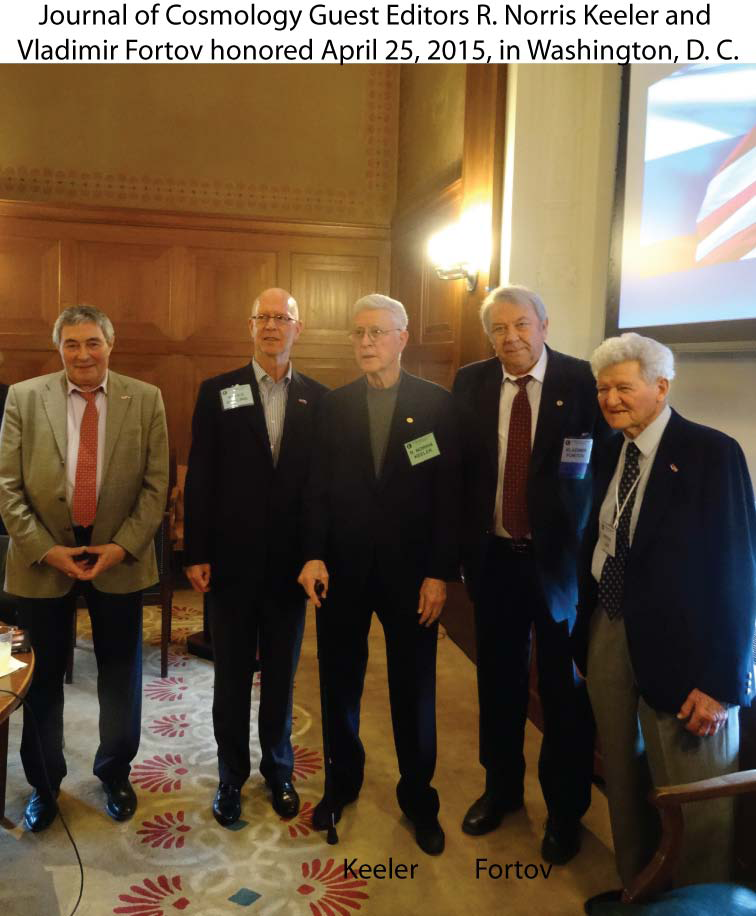
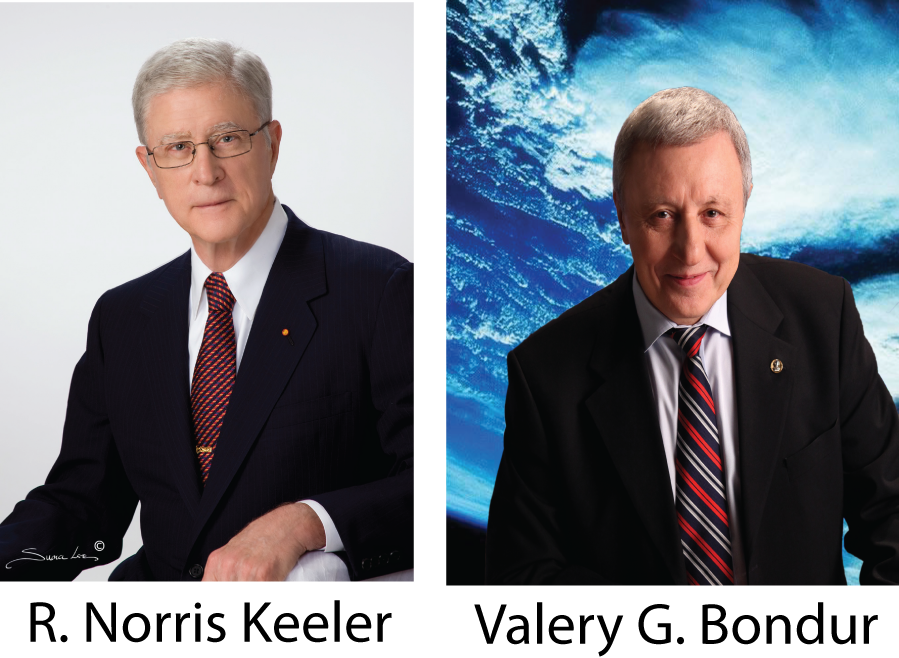
Radio telescope studies of pulsar signals produce nearly twelve decades of spectra with the characteristic (velocity) "Kolmogorovian" -5/3 power law slope, also expected for
the inertial subrange of turbulent mixing of fossil turbulence electron density (ie; an "Obukhov-Corrsin" subrange, expected to be -5/3 for 3D spectral estimates).
This "great power law on the sky" has been a mystery since it was discovered by Armstrong, Cordes and Rickett in 1981. How can the local interstellar medium of gas and dust be
turbulent? Clearly we are embedded in a PGC clump of dark matter planets, like all other stars. Then the observations can be understood from Hydro-Gravitational-Dynamics
HGD Cosmology and modern fluid mechanics, where turbulence is defined in terms of the inertial vortex forces, and fossil turbulence waves dominate transport processes
in self gravitationally dominated structures such as stratified gas planets in proto-globular-star-cluster PGC clumps that form the dark matter of galaxies. Note
that the direction of the turbulence kinetic energy cascade is always from small (planet) scales where vorticity is generated, to large (PGC) scales where it is fossilized.
The power laws (red arrows, Gibson 1968ab) shown in the Figure require gas densities of dark matter planet atmospheres at least a billion times the Galaxy average
to sustain turbulence,which supports the Schild (1996) and Gibson (1996) claim that the missing mass of galaxies is Earth-mass gas planets in trillion planet clumps.
The remarkable uniformity of the pulsar power sources and dark matter planet densities within a PGC clump, as implied by the Figure, is predicted by HGD cosmology. Extreme
non-uniformity is predicted by LCDMHC-cosmology turbulence concepts such as the excursion-set formalism of P. F. Hopkins which neglects viscosity, fossil turbulence
and fossil turbulence wave motions of BZTMA mixing chimneys crucial to the formation and evolution of gravitational structures in cosmology and astrophysics. The
concept of supersonic turbulence is an oxymoron if one accepts the recommended HGD-cosmology inertial-vortex-force definition of turbulence. Shock layers are mixed away.
Beamed Zombie Turbulence Maser Action (BZTMA) Mixing Chimneys produce the Great Power Law on the sky
Studies of stratified turbulence in Hawaii (see 2012 JoC Vol. 17) with Russian colleagues has produced a generic stratified turbulence mixing mechanism
termed (beamed zombie turbulence maser action) BZTMA Mixing Chimneys. It applies to self-gravitational (stars, planets), oceanic and atmospheric
systems.
Dr. R. Norris Keeler and Academician V. Bondur planned the experiments and are Guest Editors for this special volume of the Journal of Cosmology.
The experiments were funded by the US Government to test Russian claims that methods existed to detect submerged turbulence sources such as municipal
outfalls from sea surface brightness fluctuations detected by space satellites. The Sand Island municipal outfall was selected as the source of submerged
stratified turbulence three miles off-shore from the Honolulu airport at 70 meters depth, trapped and fossilized by stable stratification at a depth of 50 meters.
The experiments, termed the Remote Anthropogenic Sensor Program RASP, and were carried out in 2002, 2003 and 2004. Results are discussed in the Ph. D.
Dissertation of Dr. Pak Tao Leung, (Journal of Cosmology Vol. 17, pp 7612-7750) who participated in the microstructure data acquisition and its
analysis for each year of the experiment. Dr. Leung demonstrates the crucial importance of hydrodynamic phase diagrams to studies of stratified turbulence.
R. N. Keeler awarded medal by Vladimir Fortov, Pres. Russian Academy of Sciences, April 25, 2015, Washington D. C.pp 8882-8884. Keeler and Fortov are guest editors for Vol. 18
of the Journal of Cosmology on Extreme Conditions of the Universe. Both are experts on these conditions, as shown in
Vol. 18. especially No. 13 & 14.
CONTENTS
ARTICLES
I. Academician of the Russian Academy of Sciences (RAS) V. G. Bondur and his Russian colleagues: Aspects of the RASP data.
1. Peculiar Discontinuities in Small Scale Currents at the Shelf in the Area of Natural Convection Impact, V. G. Bondur, Yu. V. Grebenyuk, and K. D. Sabinin (translation from Doklady article in Russian). pp 8900-8905
2. Thin vortexes in the current field of Mamala Bight (Hawaii),
V. G. Bondur, Yu. V. Grebenyuk, and K. D. Sabinin. pp 8906-8908
3. Internal Waves on Continental and Island Shelves of the Open Ocean: A Comparative Analysis for Observations on the New York and Hawaii Shelves,
V. G. Bondur, Yu. V. Grebenyuk, and K. D. Sabinin. pp 8909-8918
4. Peculiarities of Internal Tidal Wave Generation near Oahu Island (Hawaii),
V. G. Bondur, Yu. V. Grebenyuk, and K. D. Sabinin. pp 8919-8930
5. The Spectral Characteristics and Kinematics of Short-Period Internal Waves on the Hawaiian Shelf,
V. G. Bondur, Yu. V. Grebenyuk, and K. D. Sabinin. pp 8931-8941
6. Variability of Internal Tides in the Coastal Water Area of Oahu Island (Hawaii),
V. G. Bondur, Yu. V. Grebenyuk, and K. D. Sabinin. pp 8942-8953
7. Mathematical Modeling of Turbulent Jets of Deep-Water Sewage Discharge into Coastal Basins, V. G. Bondur, V. M. Zhurbas, and Yu. V. Grebenyuk. pp 8954-8969
8. Modeling and Experimental Research of Turbulent Jet Propagation in the Stratified Environment of Coastal Water Areas,
V. G. Bondur, V.M. Zhurbas, Yu. V. Grebenyuk, and K. D. Sabinin. pp 8970-8982
9. Studies of Hydrophysical Processes during Monitoring of the Anthropogenic Impact on Coastal Basins Using the Example of Mamala Bay of Oahu Island in Hawaii, V. G. Bondur, N. N. Filatov, Yu. V. Grebenyuk, Yu. S. Dolotov, R. E. Zdorovennov, M. P. Petrov, and M. N. Tsidilina. pp 8983-9002
10. Satellite Recording and Modeling of Short Internal Waves in Coastal Zones of the Ocean, V. G. Bondur, Yu. V. Grebenyuk, and E. G. Morozov. pp 9003-9008
11. RESEARCH OF HIGH-FREQUENCY INTERNAL WAVES AT THE SHORE BORDER USING SPECTRA OF SPACE OPTICAL IMAGERY, V. G. Bondur and A. Sh. Zamshina. pp 9009-9019
12. Anthropogenic Influence on the Planktonic Community in the Basin of Mamala Bay (Oahu Island, Hawaii) Based on Field and Satellite Data, V. I. Vedernikov, V. G. Bondur, M. E. Vinogradov, M. R. Landry, and M. N. Tsidilina. pp 9020-9037
13. Monitoring of Anthropogenic Influence on Water Areas of Hawaiian Islands Using RADARSAT and ENVISAT Radar Imagery, V.Bondur, S.Starchenkov. pp 9038-9042
14. Features of Formation of Remote Sensing and Sea truth Databases for The Monitoring of Anthropogenic Impact on Ecosystems of Coastal Water Areas, V.Bondur, M.Tsidilina. pp 9043-9047
15. Monitoring of Anthropogenic Influence on Mamala Bay Water Area (Hawaii) Using IKONOS and QuickBird Imagery, V.Bondur, V.Vorobev. pp 9048-9042
16. Surface Manifestations of Internal Waves Investigated by a Subsurface Buoyant Jet: 1. The Mechanism of Internal-Wave Generation, V. G. Bondur, Yu. V. Grebenyuk, E. V. Ezhova, V. I. Kazakov, D. A. Sergeev, I. A. Soustova, and Yu. I. Troitskaya. pp 9053-9065
17. Surface Manifestations of Internal Waves Investigated by a Subsurface Buoyant Jet: Part 2. Internal Wave Field,
V. G. Bondur, Yu. V. Grebenyuk, E. V. Ezhova, V. I. Kazakov, D. A. Sergeev, I. A. Soustova, and Yu. I. Troitskaya.9066-9079
18. Surface Manifestations of Internal Waves Investigated by a Subsurface Buoyant Jet: 3. Surface Manifestations of Internal Waves,
V. G. Bondur, Yu. V. Grebenyuk, E. V. Ezhova, V. I. Kazakov, D. A. Sergeev, I. A. Soustova, and Yu. I. Troitskaya. pp 9080-9090
19. Complex Satellite Monitoring of Coastal Water Areas, V. G. Bondur. pp 9091-9098
II. Publications describing the RASP (Remote Anthropogenic Sensing Program) results. Summary powerpoint presentation,
Gibson 2005.
20. Remote Sensing of Submerged Oceanic Turbulence and Fossil Turbulence, C. H. Gibson, V. G. Bondur, R. N. Keeler, Pak Tao Leung, Int. Journal of Dynamics of Fluids, Vol. 2, No. 2 (2006), pp. 111-135. pp 9199-9241
21. Energetics of the Beamed Zombie Turbulence Maser Action Mechanism for Remote Detection of Submerged Oceanic Turbulence, C. H. Gibson, V. G. Bondur, R. N. Keeler, Pak Tao Leung. Journal of Cosmology (2013), pp 7751-7787
22. New Cosmology II, C. H. Gibson. Freshman seminar textbook UCSD SIO 87, Winter 2013. RASP articles are included. pp 9279-9398
23. Submerged turbulence detection with optical satellites, Carl H. Gibson, R. Norris Keeler, Valery G. Bondur, Pak T. Leung, H. Prandke, D. Vithanage. pp 9399-9407
24. Optical satellite imagery detection of internal wave effects from a submerged turbulent outfall in the stratified ocean, R. Norris Keeler, Valery G. Bondur, Carl H. Gibson. pp 9408-9413
25. Turbulence instruments measure anthropogenic effects in coastal ocean waters, F. Wolk, H. Prandke, C. H. Gibson. pp 9414-9422
26. Vertical stratified turbulent transport mechanism indicated by remote sensing, Carl H. Gibson, R. Norris Keeler, Valery G. Bondur. 9423-9426
27. Turbulence and fossil turbulence in oceans and lakes, Pak Tao Leung and Carl H. Gibson (Chinese Journal of Oceanology and Limnology, 22, pp.1–23 (January 2004). astro-ph/0110248). 9427-9450
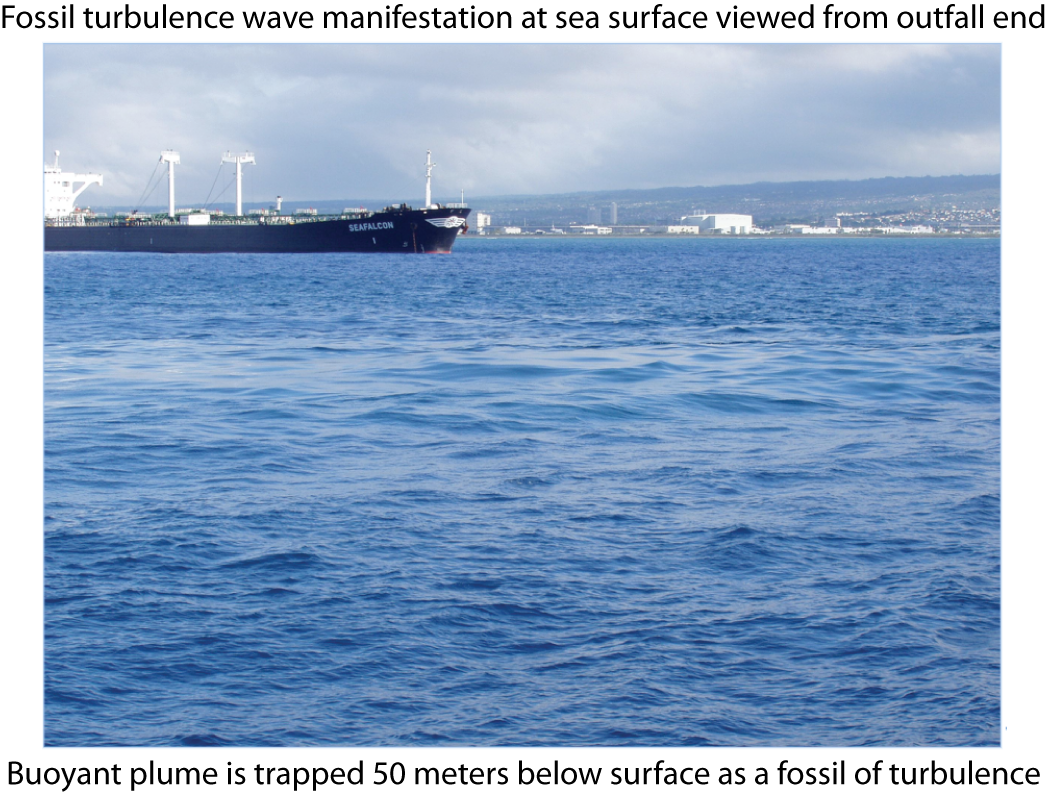
Internal waves radiated from the Sand Island municipal outfall fossil turbulence sometimes smooth the sea surface, as shown in this view looking west from the ship HAPA positioned over the 70 m depth end of the diffuser. No indicators of wastewater transport such as discoloration or smell were detected in the slick.
28. Formation of turbulence on a tilted density interface, Carl H. Gibson and Jorg Imberger. pp 9451-9481
29. Turbulence and turbulent mixing in natural fluids, Carl H. Gibson. pp 9482-9492
30. May turbulence and fossil turbulence lead to life in the universe? , Carl H. Gibson. pp 9493-9507
31. Why don't clumps of cirrus dust gravitationally collapse?, Schild, Gibson, Nieuwenhuizen, Wickramasinghe. pp 9508-9514
32. Mixing events in the seasonal thermocline during MILE: Intercomparison of turbulent sampling techniques, Libe Washburn and Carl Gibson. pp 9934-9988. Commented by CHG about the 30 year delay in publication.
33. A Review of “Marine Turbulence: Theories, Observations, and Models” , R. Norris Keeler. pp 9541-9548
III. Cosmology
34. C-FIELD COSMOLOGY WITH VARIABLE GRAVITATIONAL CONSTANT IN 5-DIMENSIONAL HOMOGENEOUS DUST UNIVERSE, Raj Bali and Meghna Kumawat, pp 9515-9529
35. Two Means by which Magnetized Cosmic Bodies can Seed the Universe with Life, R. D. Belian pp 9530-9540
36. Sri Lanka Red Rain, Chandra Wickramasinghe pp 9549-9551
Professor Wickramasinghe and his wife Priya were visiting Sri Lanka in late 2012 during spectacular episodes of red rain and meteor showers. Samples of the rain and the meteors were collected and are under analysis. All observations so far indicate further evidence of extraterrestrial life . The red version of the organism is a resting phase of this hyperextremophile, observed (Lewis and Kumar) to reproduce itself at a maximum rate at about 300 degrees centigrade and survive temperatures of over 357 C. See the Sri Lanka "The Nation" (Tharaka Gamage, 15 Dec. 2012) interview 'Red rain from outer space'' -- Prof. Chandra Wickramasinghe, pp 9552-9559
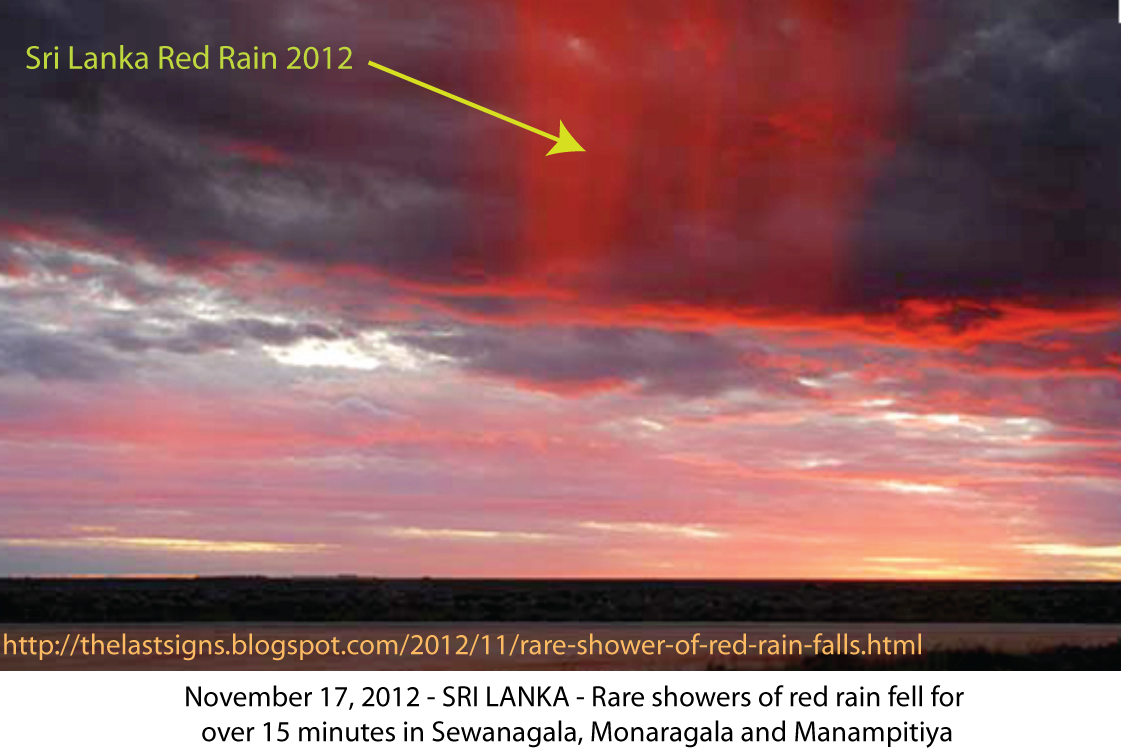

37. FOSSIL DIATOMS IN A NEW CARBONACEOUS METEORITE, N. C. Wickramasinghe, J. Wallis, D.H. Wallis and Anil Samaranayake, pp 9560-9571
Skepticism is evident in the Wikipedia report of this paper, which attacks the messenger by referring to the "fringe science" Journal of Cosmology. Nowhere in the diatom Wikipedia article do we see a discussion of cometary panspermia as an alternative to terrestrial evolution to explain the surprising diatom variability in the fossil record.
38. ON THE COMETARY ORIGIN OF THE POLONNARUWA METEORITE, N. C. Wickramasinghe, J. Wallis, D.H. Wallis, M.K. Wallis, S. Al-Mufti, J.T. Wickramasinghe, Anil Samaranayake and K. Wickramarathne, pp 9572-9578
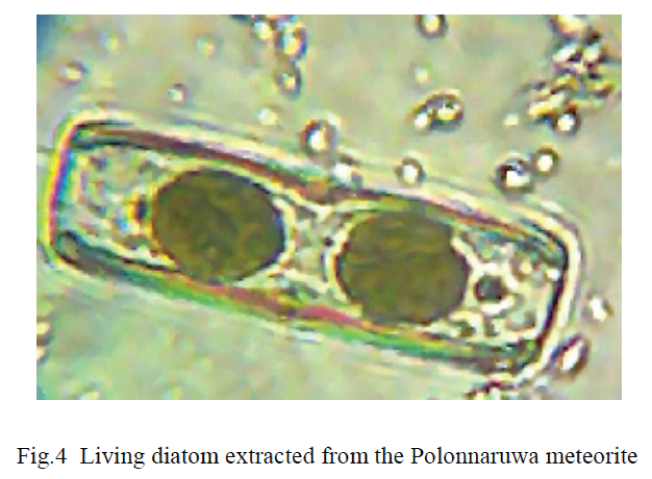
39. AUTHENTICITY OF THE LIFE-BEARING POLONNARUWA METEORITE, N.C. Wickramasinghe, J. Wallis, N. Miyake, Anthony Oldroyd, D.H. Wallis, Anil Samaranayake and K. Wickramarathne , Richard B. Hoover and M.K. Wallis, pp 9772-9777
40. LIVING DIATOMS IN THE POLONNARUWA METEORITE – POSSIBLE LINK TO RED AND YELLOW RAIN, N.C. Wickramasinghe, K. Wickramarathne, Anil Samaranayake, D.H. Wallis, Richard B. Hoover, Carl H. Gibson and Jamie Wallis, pp 9797-9804
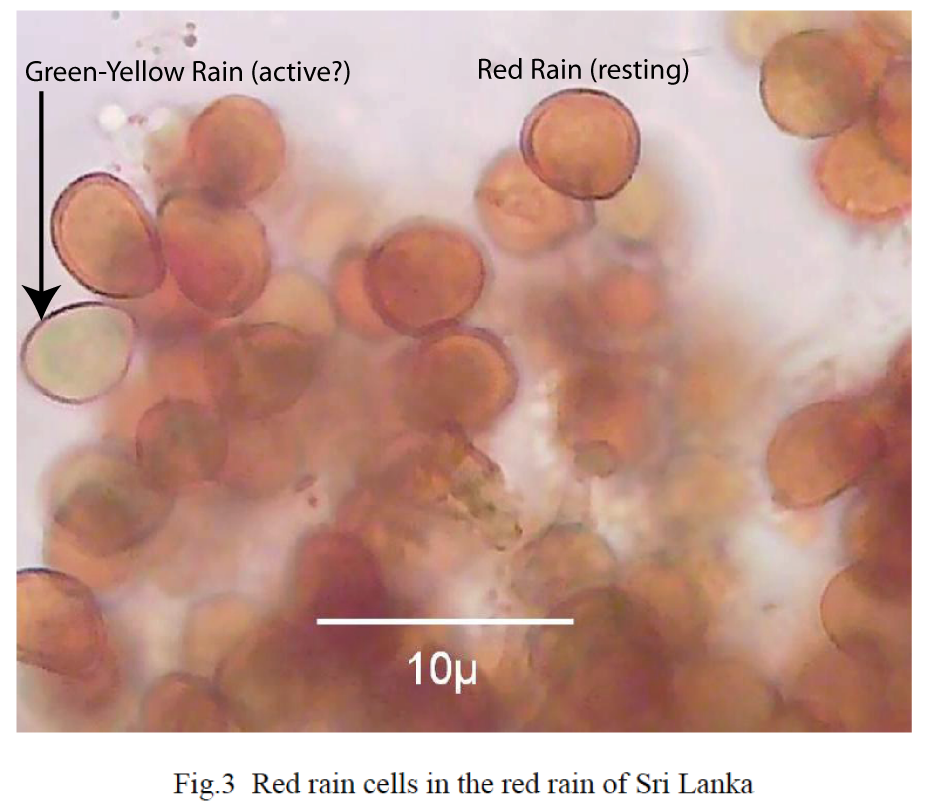
41. Fluid mechanics leads to life in the universe, Carl H. Gibson (SPIE 8521-10 Conference Preprint), pp 9666-9675
42. Extraterrestrial life contradicts dark energy, Carl H. Gibson (SPIE 8521-20 Conference Preprint), pp 9676-9681
43. Can a Complex Scalar Field Accelerate the Universe?, Kanika Das and Nawsad Ali, pp 9778-9796
44. Microorganisms in the Coloured Rain of Sri Lanka, Anil Samaranayake, K. Wickramarathne, and N. C. Wickramasinghe, pp 9805-9810
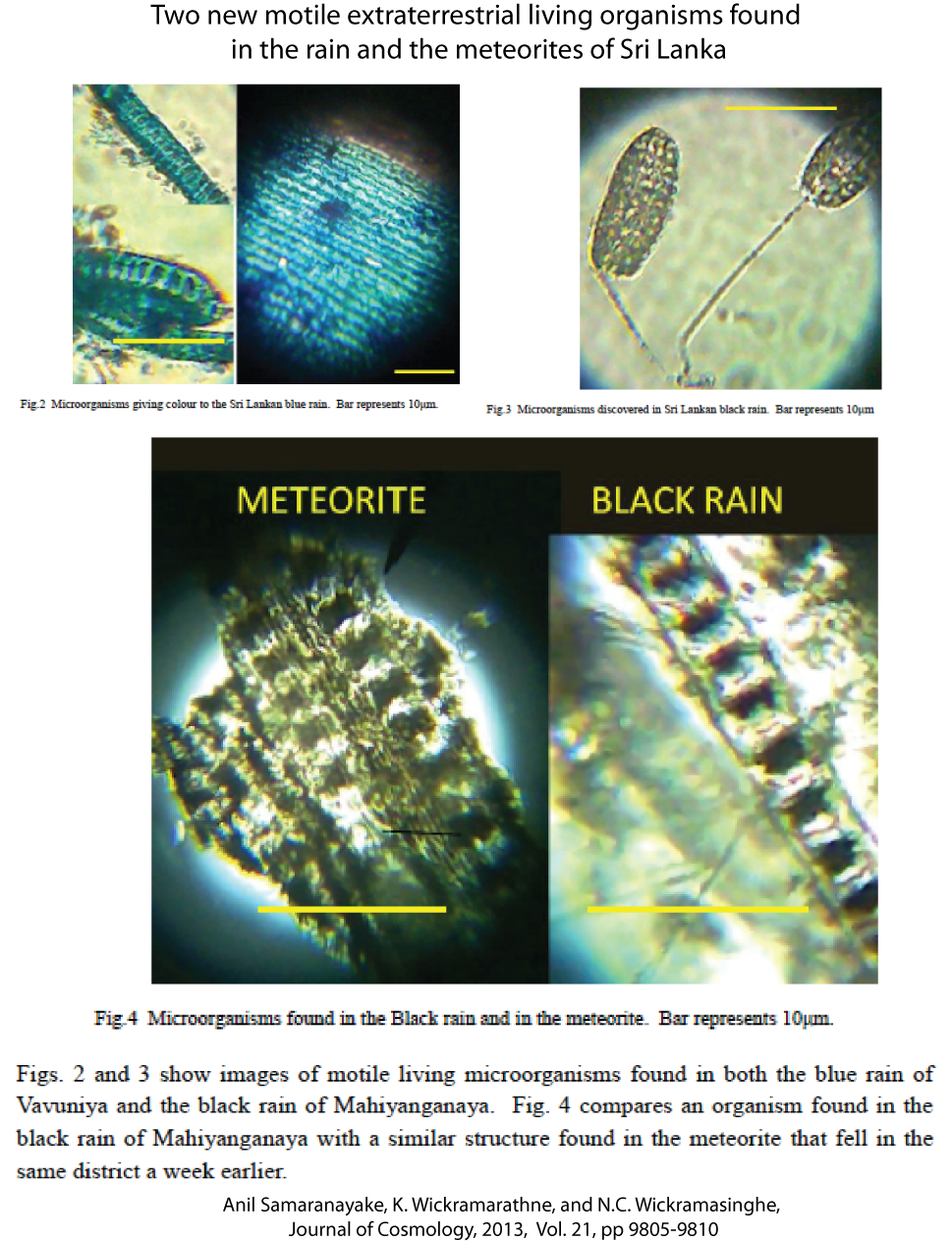
45. Atlas of Microorganisms in Coloured Rains and Meteorites in Sri Lanka, Anil Samaranayake, K. Wickramarathne and S.P.D. Karunanayake, pp 9811-9815
Dr. Samaranayake is Director of the Medical Research Institute in Sri Lanka and has agreed to be Guest Editor for Volume 22 of the Journal of Cosmology.
IV. Terrestrial remote sensing of submerged ocean turbulence and stratified oceanic turbulent mixing
46. AEROSPACE METHODS IN MODERN OCEANOLOGY, V.G. Bondur, pp 9579-9655
47. Report in Russian 2011 (Bondur, Grebenyuk, Sabinin, pp 9656-9665
48. Satellite Monitoring and Mathematical Modelling of Deep Runoff Turbulent Jets in Coastal Water Areas, Valery G. Bondur, pp 9682-9708
49. Fine Vortex Columns on the Shelf in the Area of Bottom Convection Influence, V. G. Bondur, Yu. V. Grebenyuk, S. I. Muyakshin, and K. D. Sabinin, pp 9709-9717
50. Study of physical processes in coastal zone for detecting anthropogenic impact by means of remote sensing, Valery G. Bondur and Nikolai N. Filatov, pp 9718-9725
51. MONITORING POLLUTION OF THE OCEAN COASTAL WATER AREAS USING HIGH RESOLUTION SPACE MULTISPECTRAL IMAGERY 2006, V.G. Bondur, R.N. Keeler, S.A. Starchenkov, N.I. Rybakova, pp 9726-9741
52. Applying of PIV/PTV Methods for Physical Modeling of the Turbulent Buoyant Jets in a Stratified Fluid, Valery Bondur, Yurii Grebenyuk, Ekaterina Ezhova, Alexander Kandaurov, Daniil Sergeev and Yuliya Troitskaya, pp 9742-9764
53. Sea Truth Measurements for Remote Sensing of Littoral Water, Comprehensive Sea Truth Measurements Carried out on Oahu Island to Support Satellite Imagery of the Ocean, R. Norris Keeler, Valery G. Bondur, Dayan Vithanage, pp 9765-9771
54. Anomalous Variation of the Ocean’s Inertial Oscillations at the Hawaii Shelf, Academician V. G. Bondur, K. D. Sabinin, and Yu. V. Grebenyuk, pp 9772-9777
55. Helicity and the Inverse Turbulence Cascade, R. N. Keeler, Carl H. Gibson and John G. Pierce, pp 9816-9829
56. SPECIFIC SMALL-SCALE VORTICES (“VORTEX COLUMNS”) IN THE SEA SHELF AREAS DUE TO THE NEAR-BOTTOM CONVECTION, V.G.Bondur, Yu.V.Grebenyuk, R.N. Keeler, K.D.Sabinin, S.I.Muyakshin, C.H. Gibson, pp 9830-9850
57. Wake Signature Detection, Geoffrey R. Spedding, pp 9851-9881
58. Fossil turbulence and fossil turbulence waves permit remote sensing of submerged submarines, Carl H. Gibson, pp 9882-9894 JARS version. Reviewer comments.
Evidence of extreme turbulence and fossil turbulence mixing chimneys at equatorial latitudes is shown by AF 447 and MH 370 crashes that imply catastrophic icing conditions. BZTMA mixing chimneys may transport supercooled water vapor and strong turbulence to unusually high altitudes. At mid-latitudes pilots can usually change their flying altitude to escape an icing layer. Near the equator with global warming, the number of such death traps may be increasing. The AF 447 plane passed through a region of strong thunderstorms on the first day of hurricane season. The MH 370 plane may have encountered not only clear air turbulence but the clear air icing conditions of high altitude supersaturated water vapor.
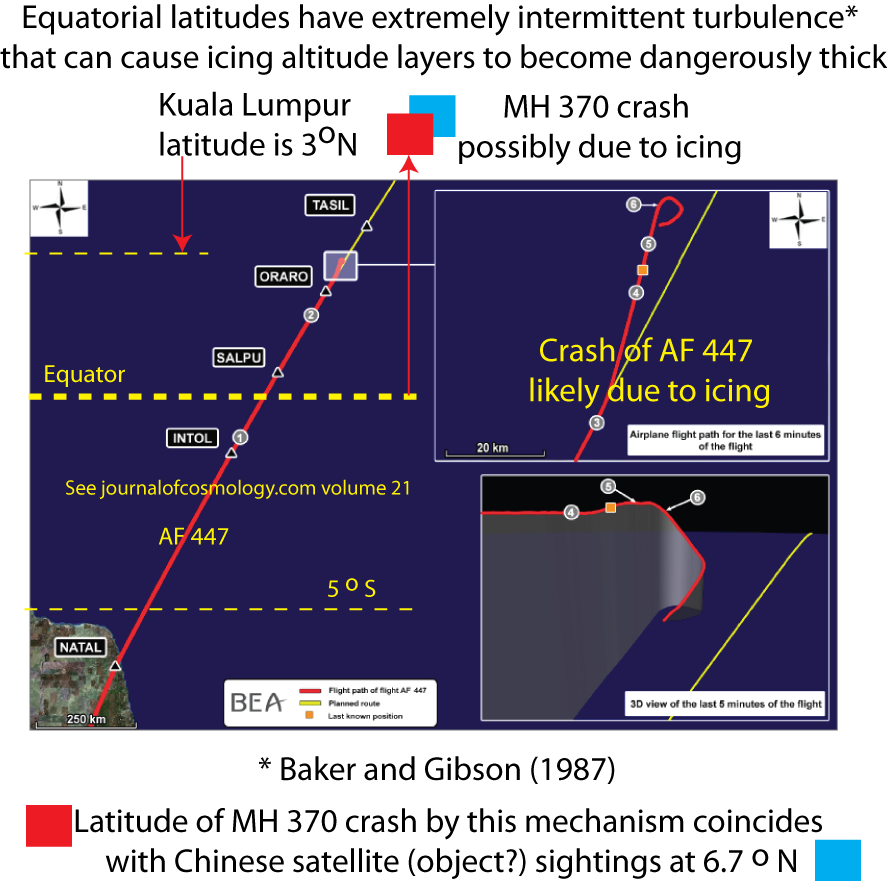
The following Chinese satellite image was displayed for only two hours on March 9, between 9 am and 11 am. The image was removed as a "mistake" but so far has not been repudiated or explained. The mistake appears to be that the longitude was written down as 105.63 E rather than 103.63 E, which is far off the flight path. The reported objects matched the size of a broken aircraft, but were gone when two search planes looked for them on March 11 at the 105.63 E longitude and found nothing. Three images were displayed from different times, judging from the different clouds and different object dispersions. Signals from MH 370 detected by satellite persisted until 8:11 am, 1.5 hrs beyond the expected flight time. No attempts to detect black box flight recorder signals with underwater sensors on the flight path have been reported as of March 17.
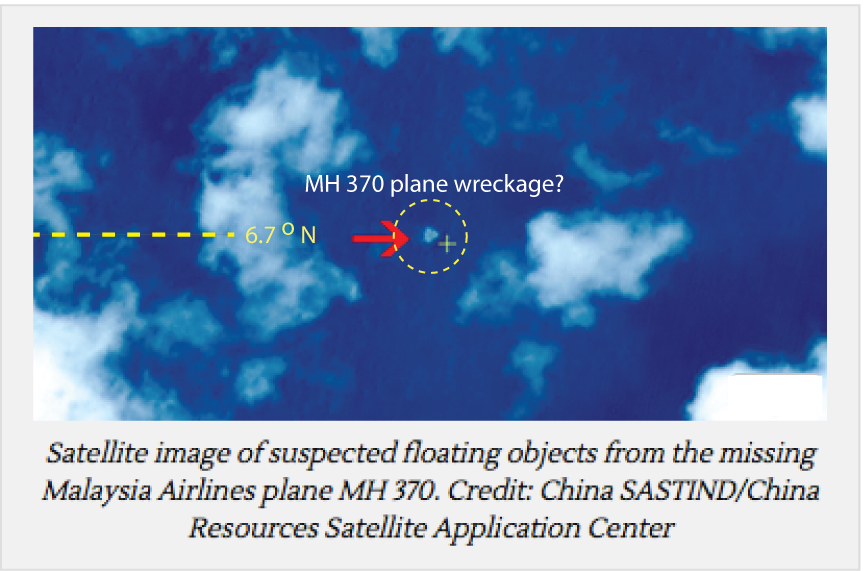
The AF 447 catastrophe clearly indicates the plane was doomed from the moment it hit the extreme-equatorial-intermittency BZTMA mixing chimney. A similar fate is indicated for MH 370. Present clear air turbulence models have no latitude dependency, which is the fault of ignorance of equatorial turbulence by the scientific community, not the pilots. Planes are not equipped with the necessary Lidar turbulence sensors needed. The following is from a front page Wall Street Journal clipping in 5/2011, blaming the pilots. There is no evidence whatsoever to suggest pilot confusion, or pilot error, in the 4 minutes it took for the icing events shown to debilitate the plane and force it to rapidly fall to the sea surface and crash. Because of the icing, the three experienced AF pilots in the cockpit lost all control of the plane except for its engine power, which the pilots properly reduced to idle just before it hit the water.
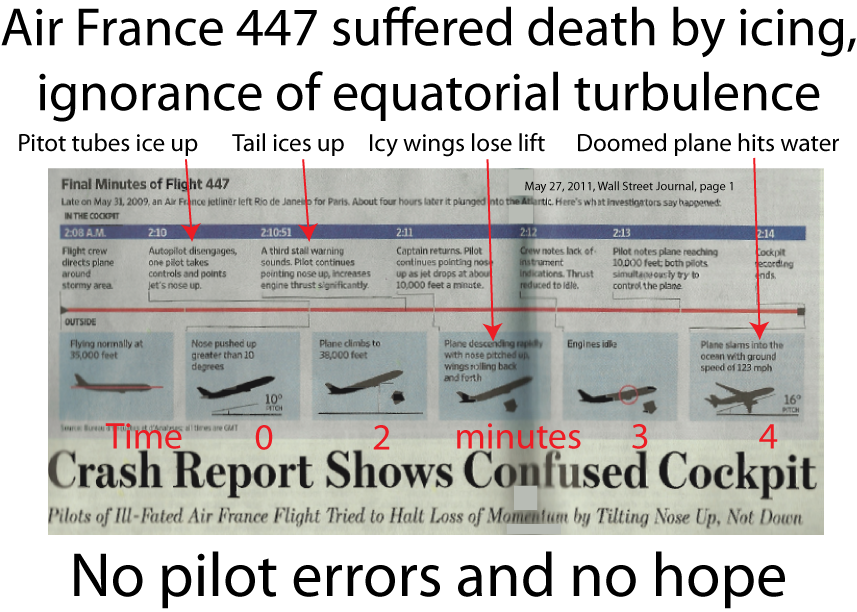
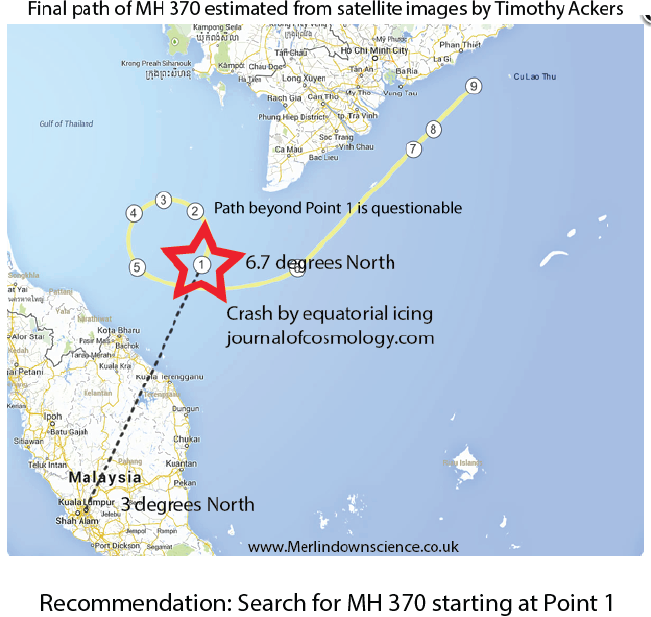
Press Release: Could Wild Seas have caused the Malaysian Plane Crash?
The Cosmic Web and Microwave Background Fossilize Big Bang Turbulent Combustion, Carl H. Gibson and R. Norris Keeler, Presentation at IAU 308 Conference "Zeldovich and the Cosmic Web", June 23-28, 2014, Tallinn, Estonia.
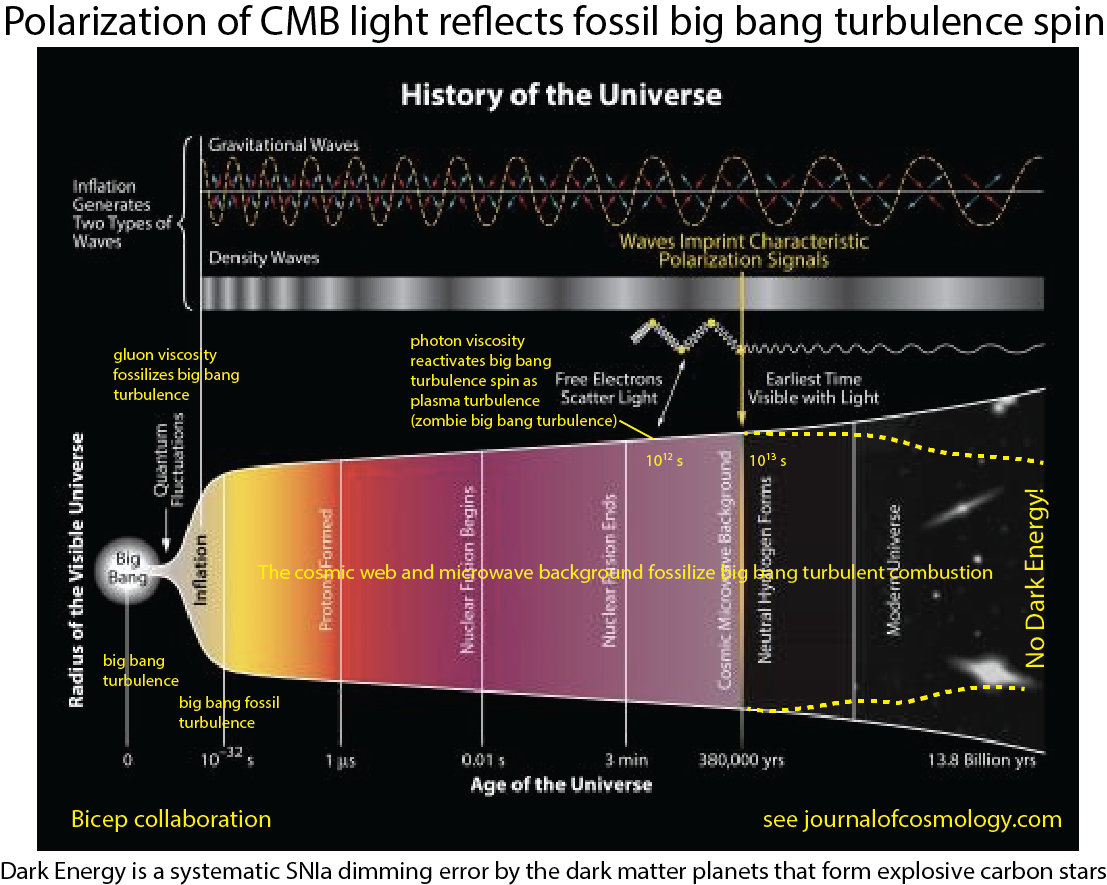
59. Fossil turbulence revisited, Carl H. Gibson, pp 9895-9925
60. The study of mixing in the ocean: a brief history, Michael C. Gregg, Commentary by Carl H. Gibson on this Oceanography 1991 article. Gregg's paper reveals the appalling lack of sensitivity among oceanographers to the importance of intermittency, fossil turbulence and fossil turbulence waves to mixing in the ocean and atmosphere (eg. BZTMA mixing chimneys). Use of only a few dropsondes to estimate average vertical transport coefficients ignores the extreme intermittency of oceanic mixing processes, and vastly underestimates ocean mixing rates based on faulty ideas about how turbulence and stratified turbulence works. Thus both quantitative and (vast!) qualitative undersampling errors occur at equatorial latitudes, where intermittency factors are maximum due to small Coriolis forces. Rather that a local maximum in mixing rates epsilon and chi inferred by Baker and Gibson (JPO paper 1987) near the equator (confirmed by the well known maximum in biological productivity), Gregg suggests a local minimum! Baker and Gibson (1987) is not referenced. (CHG). pp 9926-9933
61.Book Review: Bankrupting Physics (Unzicker, Jones), by Rudolph E. Schild
EDITORIAL BOARD